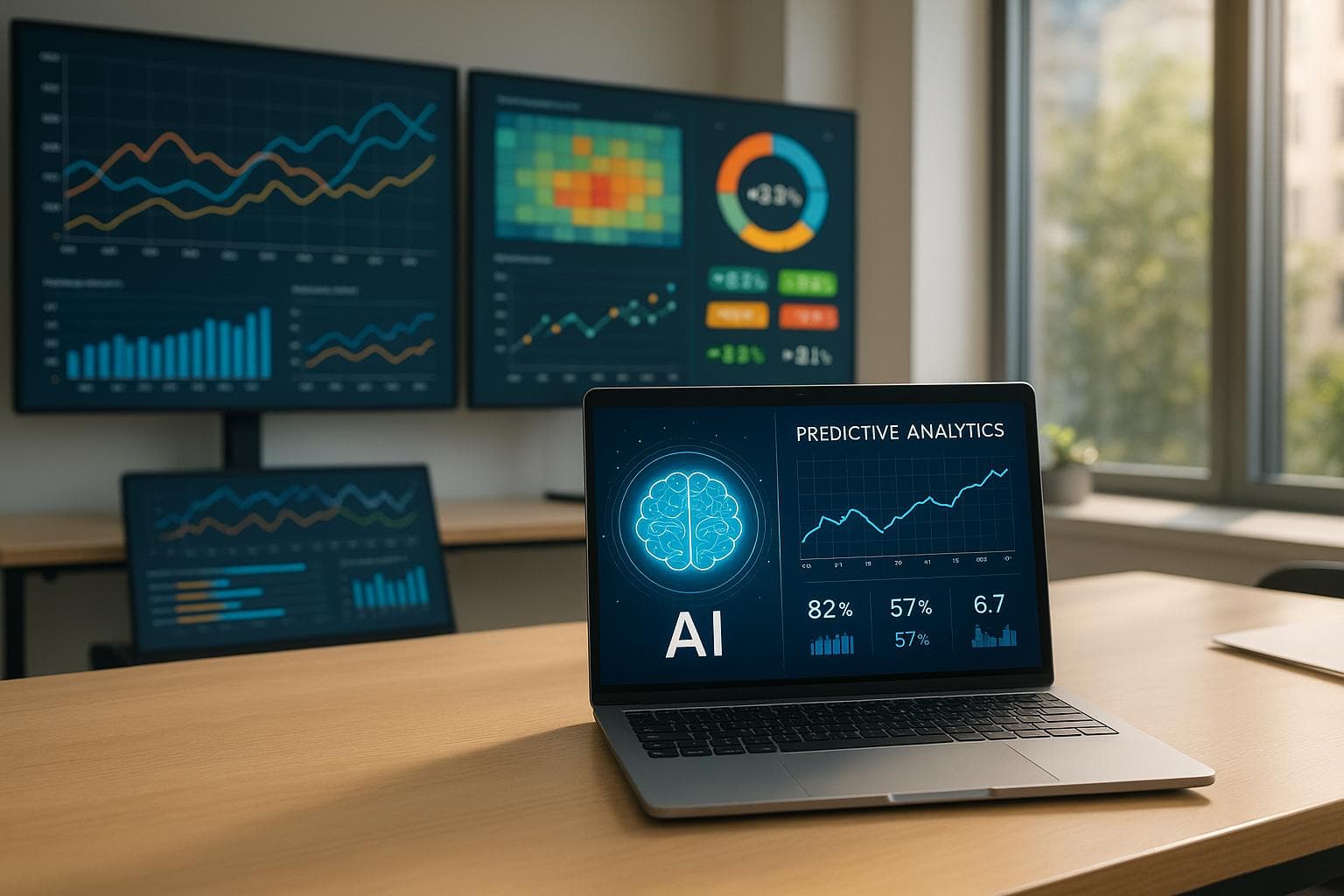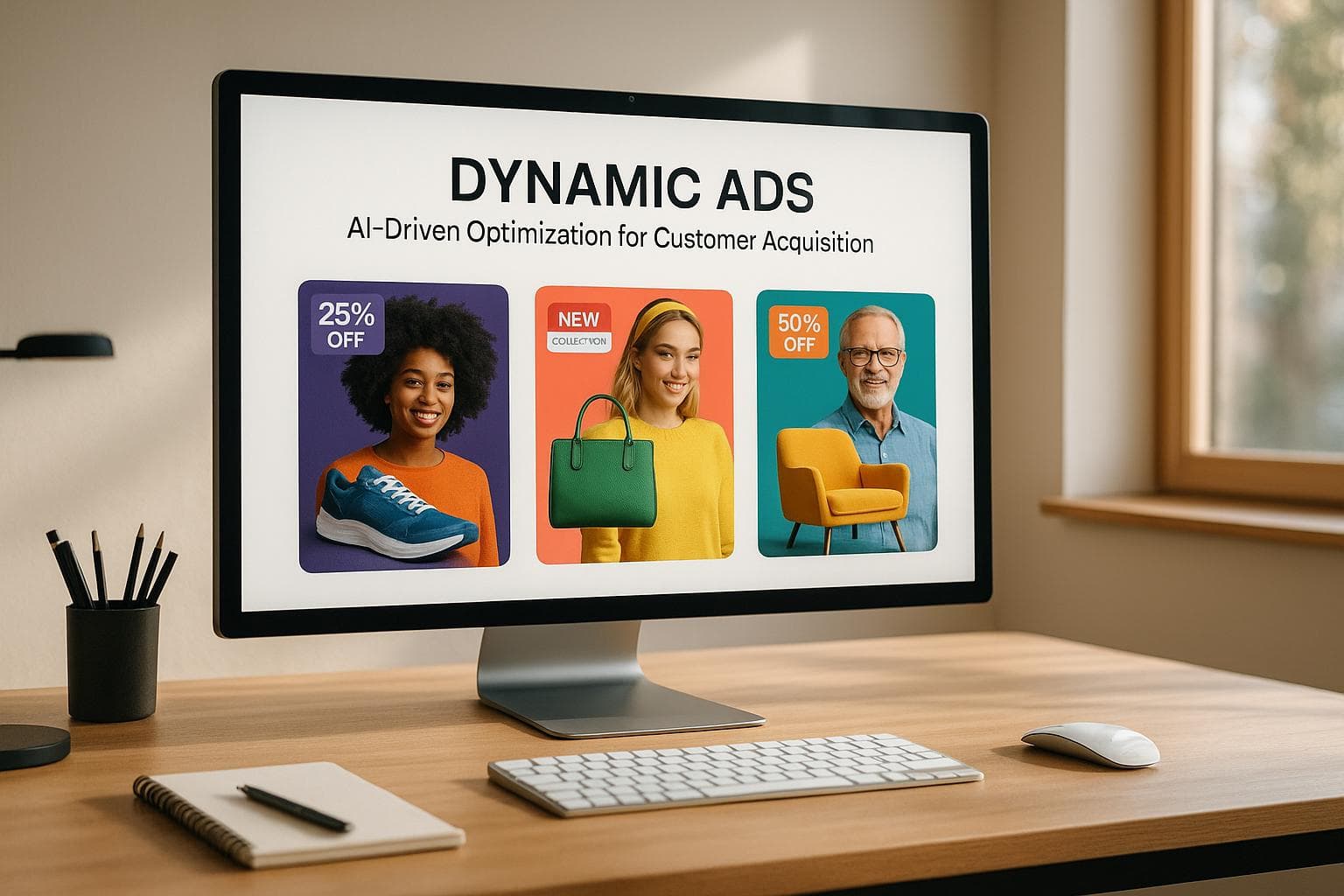Machine Learning in Facebook Ad Personalization
Explore the impact of machine learning on Facebook ad personalization, from user data analysis to enhanced targeting strategies.
Machine learning has transformed Facebook advertising, shifting from basic demographic targeting to precise, behavior-based personalization. Here's what you need to know:
- How It Works: Facebook's ad system uses machine learning to analyze user behavior, shopping habits, and even conversations with Meta AI to tailor ads in real time.
- Upcoming Changes: Starting December 16, 2025, Meta will integrate data from AI chatbot interactions to refine ad targeting further. For example, asking Meta AI about "hiking boots" could lead to seeing ads for outdoor gear.
- Benefits for E-commerce: Personalized ads can improve engagement by up to 40%, boost return on ad spend (ROAS), and simplify ad creation with tools like Dynamic Product Ads and Dynamic Creative Optimization.
- Challenges: Data privacy, limited transparency in algorithms, and reduced manual control remain hurdles for advertisers.
For e-commerce marketers, machine learning offers tools to automate ad management, optimize campaigns, and connect with high-value audiences. Success lies in maintaining high-quality product data, leveraging automation, and closely monitoring performance metrics.
How Machine Learning Works in Meta Ads (2025)
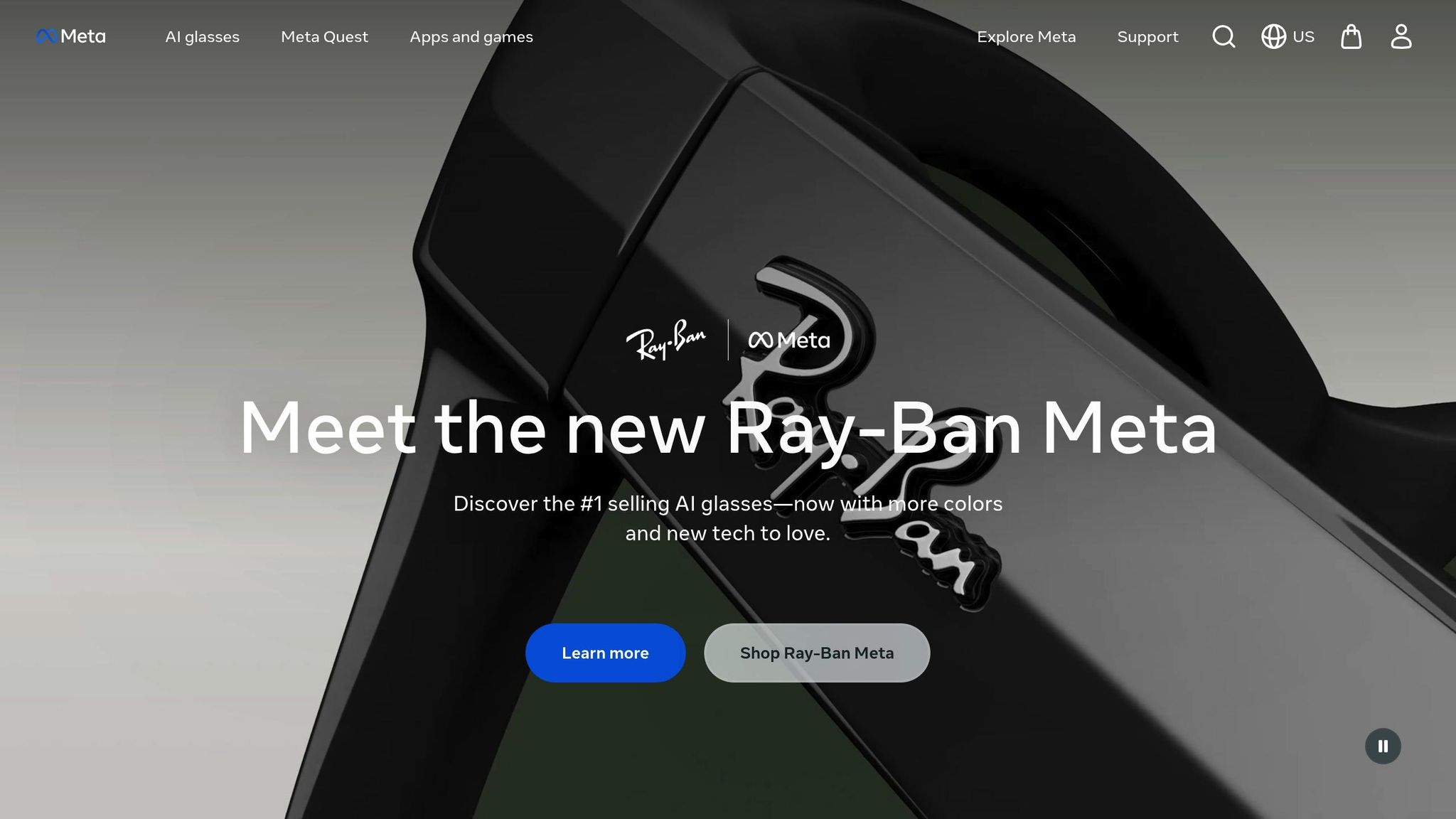
How Machine Learning Powers Facebook Ad Personalization
Facebook’s advertising system relies on machine learning to connect ads with users in real time. By processing massive amounts of user data, it analyzes behaviors to deliver ads that feel tailored to individual preferences, rather than appearing random.
The system improves with every interaction. For example, user actions and inquiries help the system predict which ads are most relevant. This ongoing learning forms the foundation of the algorithm’s functionality, as explained below.
Facebook's Ad Algorithm Basics
At its core, Facebook's ad algorithm acts as a prediction engine. It evaluates user behavior, engagement patterns, and predictive data to decide which ads are shown to each individual [2].
Starting December 16, 2025, Facebook will add a new layer to its algorithm by incorporating data from conversations with Meta AI chatbots [3]. This integration allows the system to refine ad targeting further by connecting user queries directly to ad relevance. For instance, if someone asks Meta AI about “the best running shoes for flat feet,” the system can use this private query to display ads for specialized running footwear. With over 1 billion users interacting with Meta AI monthly, this enhancement significantly sharpens targeting precision [3].
Main Factors That Determine Ad Placement
Four key elements work together to decide which ads appear in a user’s feed: available ad space, user signals, performance predictions, and relevance scores [2]. These components are dynamically balanced by machine learning models to optimize both user experience and advertiser results.
Available ad space: This refers to the limited number of ad slots in a user's feed at any given time. The algorithm determines which ads fill these slots, often functioning like a real-time auction.
User signals: These include data such as activity on Meta platforms (likes, comments, follows), shopping habits (product views, cart additions), interests, demographics, and location [2]. Recent signals carry more weight since user interests can shift quickly.
Performance predictions: The algorithm evaluates how likely a user is to take a specific action, like clicking or purchasing, based on past data. Ads with higher predicted engagement are prioritized.
Relevance scores: These scores measure how well an ad aligns with a user’s profile and current intent. For example, an ad for winter coats will rank higher for users in colder regions who have recently searched for outerwear.
While these factors rely on static data, the system also makes real-time adjustments to ensure continuous optimization.
Real-Time Ad Adjustments and Optimization
Machine learning allows Facebook’s ad system to monitor performance and user reactions in real time, making adjustments to targeting, creative elements, and bidding strategies without human input [2][4]. This constant optimization ensures campaigns adapt to shifting user behaviors and conditions throughout the day.
If an ad isn’t performing well with a specific audience, the system can quickly reallocate the budget to better-performing segments or tweak creative assets to boost engagement. For example, if video ads outperform static images for a particular campaign, the system might shift more resources toward video placements.
The algorithm also tests different creative combinations and adjusts bids based on competition and conversion likelihood. It even considers factors like time of day and device type, ensuring ads are delivered when users are most likely to engage. This dynamic approach reflects the personalized advertising process discussed earlier.
Strategies and Tools for Machine Learning in Facebook Ads
E-commerce marketers have a powerful ally in machine learning when it comes to automating campaign optimization and tailoring ads to individual users.
Dynamic Creative Optimization
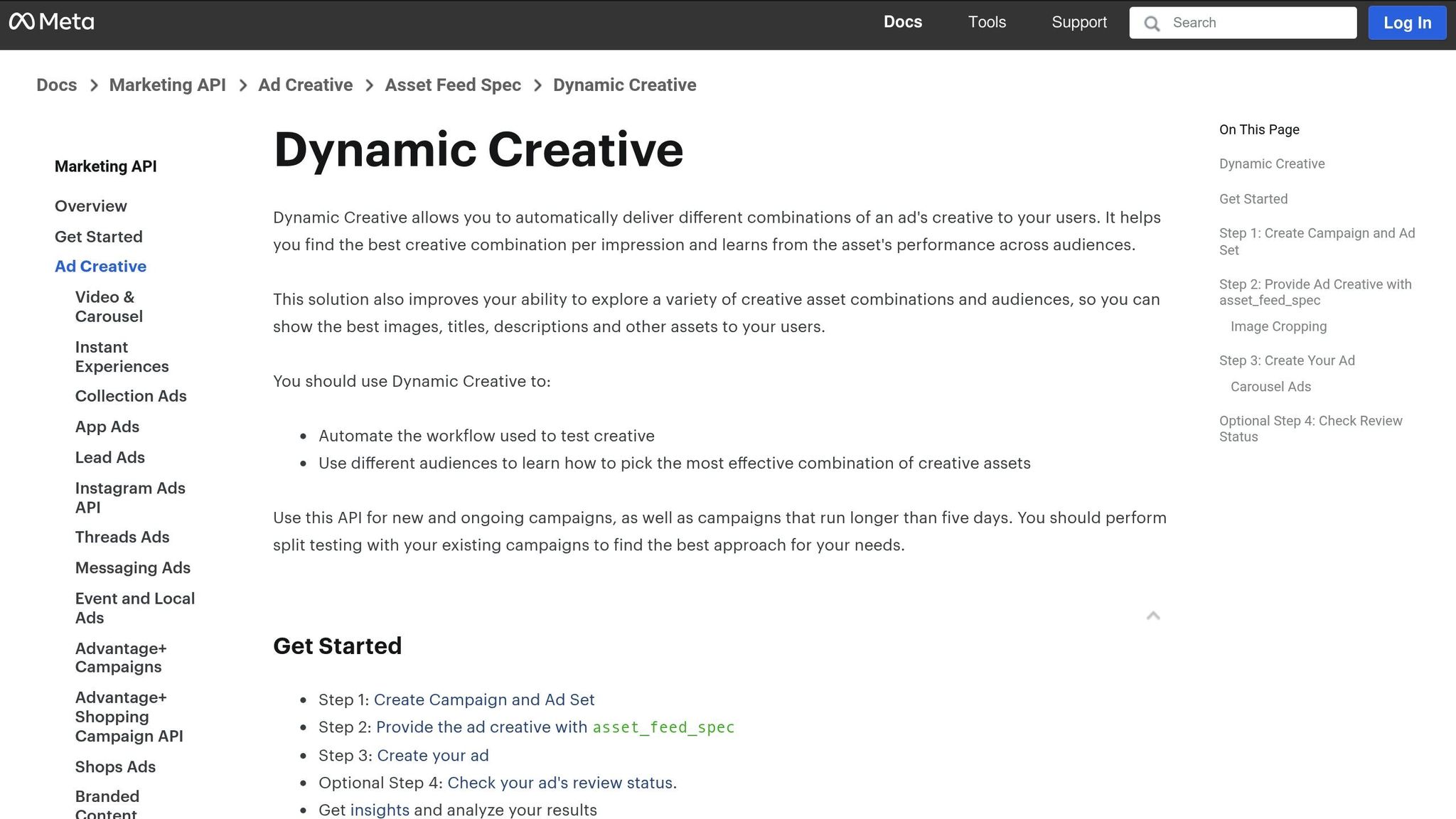
One standout feature for e-commerce brands is Dynamic Creative Optimization (DCO). This machine learning tool tests various combinations of ad elements - like images, headlines, calls-to-action, and descriptions - to find what resonates most with different audience segments [2].
The algorithm works by analyzing real-time engagement and conversion data, then automatically delivering the most effective ad combinations to each user. According to Meta's internal research, this type of personalization can boost ad engagement by as much as 40% and significantly improve return on investment (ROI) for e-commerce brands [2].
To make the most of DCO, marketers should upload a variety of creative assets for each campaign element. Facebook’s system will then handle the testing and allocate more budget to the highest-performing combinations.
Dynamic Product Ads (DPAs) are another layer to this personalization strategy. These ads automatically pull creative content from your product catalog, tailoring the experience to match individual user behavior [2].
Audience Segmentation and Lookalike Modeling
Facebook’s machine learning capabilities shine when it comes to audience analysis. It processes vast amounts of data - spanning user activity, shopping preferences, demographics, and interests - to pinpoint high-value customer segments [2][4].
Custom Audiences are a cornerstone of this approach. By using data from the Meta Pixel, brands can target site visitors, cart abandoners, and past customers. The system evaluates behavior patterns to tailor ad delivery for each segment.
On top of that, Lookalike Audiences take segmentation further by identifying new users who share similar traits with your most valuable customers [4]. Combining Custom and Lookalike Audiences allows you to both nurture existing prospects and reach new potential buyers with similar purchasing behavior.
Starting December 16, 2025, Facebook will incorporate data from Meta AI chatbot interactions into its targeting system [3]. For example, if a user asks Meta AI about hiking boots, they might later see ads for outdoor gear, making targeting even more precise.
These segmentation techniques lay the groundwork for tools like Feedcast to enhance personalization even further.
How Feedcast Improves AI-Powered Ad Personalization
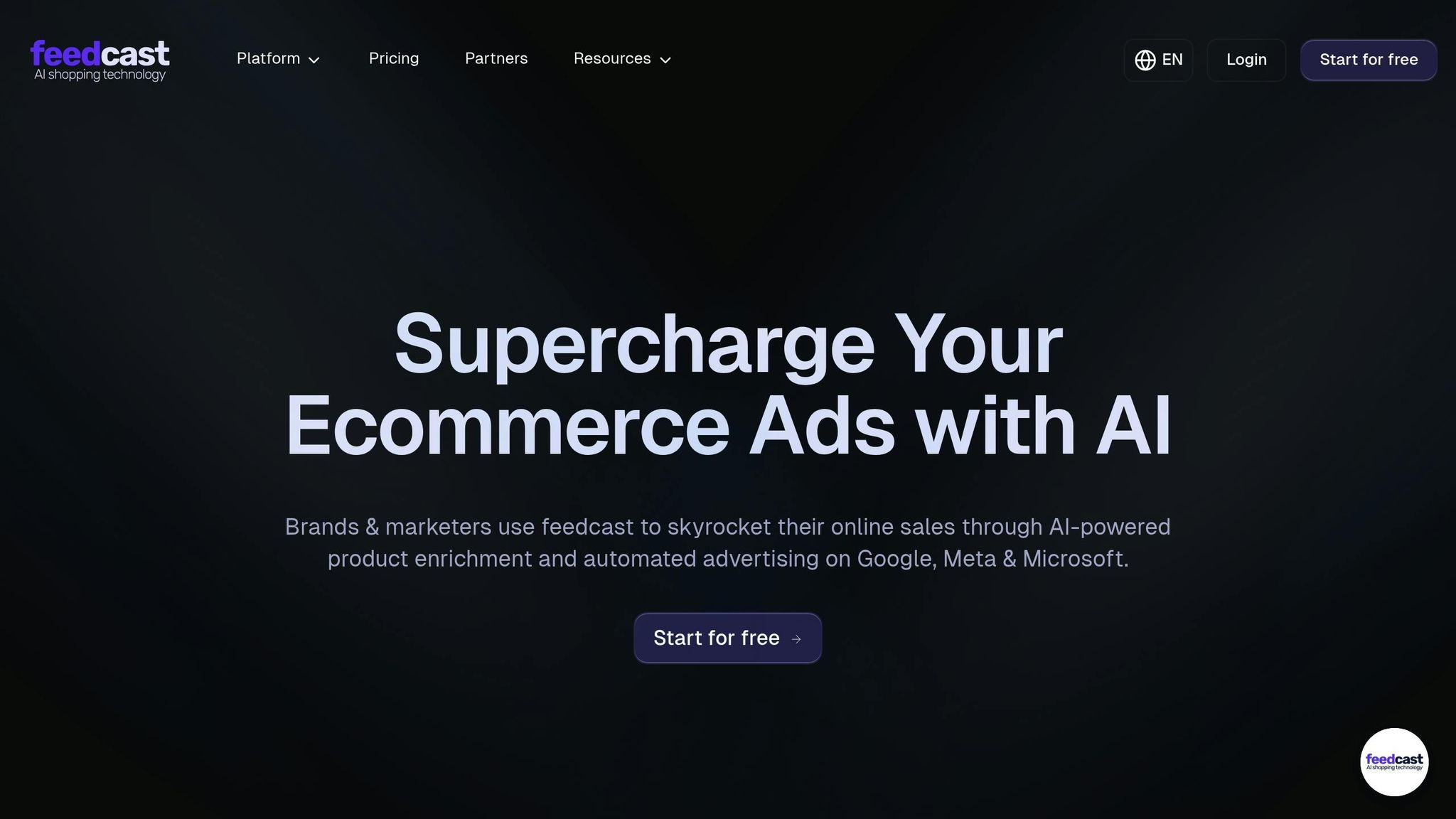
Feedcast takes Facebook ad personalization to the next level by building on dynamic creative tools and precise audience segmentation. It focuses on three main areas to amplify the effectiveness of machine learning:
AI-powered product feed management: Feedcast improves the quality of your product data, such as titles and descriptions, ensuring Facebook’s algorithms can match your products with interested users. This optimization increases visibility and ad performance on both Facebook and Instagram [1]. Currently, over 3,000 e-commerce brands rely on Feedcast to enhance their advertising efforts [1].
Automated ad creation and management: Feedcast generates personalized ad copy tailored for Facebook and Instagram. It also employs smart targeting strategies to engage both new customers and returning buyers [1]. This automation ensures that machine learning systems have access to optimized creative content at all times.
Unified analytics dashboard: Feedcast provides a centralized dashboard that connects all Facebook ad accounts, allowing marketers to track performance across channels in one place [1]. This makes it easier to identify which machine learning optimizations are driving results and adjust strategies accordingly.
Feedcast also offers flexible subscription plans, making it accessible for businesses of all sizes [1].
sbb-itb-0bd1697
Benefits and Challenges of Machine Learning in Facebook Ads
Machine learning has reshaped Facebook advertising, delivering impressive results while introducing some operational hurdles.
Benefits of Machine Learning in Facebook Ads
Machine learning significantly boosts ad performance. Studies show it can lead to up to 30% higher conversion rates compared to generic ads. Dynamic creative optimization, which adjusts ads based on user behavior, has even doubled return on ad spend (ROAS) for some advertisers [6].
Automation is another game-changer. Facebook’s system employs over 100 prediction models to continuously fine-tune ad rankings and personalize user experiences. This eliminates the need for constant manual adjustments [7].
Real-time optimization ensures campaigns operate at their best. The algorithm processes user interactions instantly, automatically tweaking placements, creatives, and targeting. This means ads are shown to the right people at the right times, maximizing both engagement and budget efficiency.
Personalized ads tailored to user interests not only boost engagement but also foster stronger connections between brands and their audiences.
The financial benefits are equally striking. For instance, over 3,000 e-commerce brands leveraging AI-driven platforms like Feedcast have reported millions of clicks and significant sales growth, illustrating the scalability of machine learning’s impact [1].
However, these advantages come with their own set of challenges.
Challenges to Consider
One major hurdle is data privacy. Meta’s evolving policies have made navigating user consent and regulatory compliance more complex [3][5].
Another issue is the lack of transparency in how algorithms operate. This opacity can make troubleshooting difficult. Additionally, biased training data can skew audience targeting, potentially reinforcing stereotypes.
Automated adjustments, while efficient, reduce the level of direct control marketers have over campaigns. This can be frustrating for advertisers who are used to fine-tuning their targeting manually.
Comparison Table: Benefits vs. Challenges
Here’s a side-by-side look at the key benefits and challenges:
| Benefits | Challenges |
|---|---|
| Up to 30% higher conversion rates with targeted ads | Data privacy concerns and regulatory hurdles |
| Doubled ROAS through dynamic creative optimization | Limited transparency in algorithmic processes |
| Time savings from automated campaign management | Risk of bias affecting audience targeting |
| Real-time optimization powered by 100+ prediction models | Reduced control over specific targeting adjustments |
| Better user engagement through personalized ads | Difficulties in diagnosing underperforming campaigns |
| Scalable results across thousands of brands | Navigating compliance with evolving regulations |
While machine learning offers undeniable advantages in terms of performance and efficiency, navigating these challenges requires careful planning. Businesses must prioritize privacy, monitor for bias, and maintain a strategic approach to ensure success.
Best Practices for E-commerce Marketers Using Machine Learning
To make the most of machine learning in Facebook ads, e-commerce marketers need more than just flipping on automated tools. The key lies in a strategic approach, focusing on three critical areas that directly influence campaign success.
Focus on High-Quality Product Data
Did you know that accurate product data can increase engagement by up to 40%? [2] This makes maintaining a complete and standardized product feed absolutely essential. For U.S. markets, ensure your feed includes precise USD pricing, up-to-date availability, high-resolution images, and detailed product descriptions. Don’t forget to use imperial measurements, the MM/DD/YYYY date format for time-sensitive campaigns, and American spelling conventions to align with local preferences.
Tools like Feedcast.ai can help streamline this process by automating the enrichment of product feeds. They enhance titles, polish descriptions, and fix feed errors, making your data more appealing and reliable. With over 3,000 e-commerce brands already on board, many have seen significant sales growth just by sticking to these high-quality data practices.
It’s also crucial to update your feeds regularly. Whether it’s a price change, inventory update, or a product detail revision, keeping your data fresh avoids the pitfalls of poor targeting, wasted ad spend, and customer dissatisfaction when items are out of stock.
A solid product data foundation is the backbone of successful automated campaign optimization.
Use Automation for Campaign Optimization
As your catalog expands, manual management becomes a bottleneck. Automation can take over routine tasks, giving you more time to focus on strategy.
Dynamic creative optimization is a game-changer. It tests different combinations of headlines, images, and calls-to-action across various audience segments, helping you discover what resonates best. Platforms like Feedcast.ai simplify this by centralizing multi-channel ad management. By linking all your ad accounts to a single dashboard, Feedcast.ai automates ad creation with AI-generated copy tailored for platforms like Facebook, while smart targeting tools help you connect with both new and returning customers.
Automation also shines in bid management and budget allocation. Instead of constantly tweaking bids throughout the day, machine learning analyzes performance data in real time, ensuring your budget is spent on the most effective audiences and placements.
Facebook’s AI, for instance, leverages lookalike audiences to broaden your reach while keeping your ads relevant [4]. These automated tools not only fine-tune your campaigns but also generate valuable data to fuel continuous improvement.
Monitor Analytics for Continuous Improvement
Analytics are your compass for navigating machine learning-driven ad strategies. By keeping a close eye on performance data, you can adapt to shifting user behaviors and refine your approach.
Focus on metrics like click-through rate (CTR), conversion rate, cost per acquisition (CPA), and return on ad spend (ROAS). Break these down by audience segments, ad placements, and creative variations to uncover trends and opportunities that might not be obvious at first glance.
Using a unified dashboard - like the one from Feedcast.ai - can provide real-time, detailed performance insights. Regular reviews of these metrics allow you to address issues quickly and spot trends worth capitalizing on.
Segmentation is particularly valuable. A campaign that seems average overall might include standout audience segments that deserve more budget or, conversely, underperforming ones that need adjustment or removal.
With Meta planning to use AI chatbot conversations for ad personalization starting December 16, 2025 [3], staying vigilant with your analytics is more important than ever. Establishing baseline metrics now will help you measure the impact of these changes and refine your strategies accordingly.
Finally, consider experimenting with ad creatives that reflect user research behaviors. Tailoring your messaging to align with how consumers evaluate products can boost engagement and relevance, keeping your campaigns ahead of the curve as automation continues to evolve.
Conclusion: Transforming Facebook Ads with Machine Learning
Machine learning has reshaped how Facebook ads work, moving from broad demographic targeting to highly personalized, behavior-driven campaigns. This shift has already led to impressive results, such as boosting engagement rates by up to 40% [2].
And there’s more change on the horizon. Starting December 16, 2025, Meta plans to incorporate AI conversation data from interactions across Facebook, Instagram, WhatsApp, and Messenger to refine ad targeting even further [3][5]. This means ads will be tailored more precisely based on user queries, creating opportunities for highly targeted product promotions.
For e-commerce marketers, these advancements offer both exciting opportunities and new challenges. The key to thriving in this evolving landscape will be adopting automation and AI-driven tools while ensuring high-quality data and careful performance monitoring. With Meta projected to invest $600 billion in AI infrastructure by 2028 [5], its machine learning capabilities are set to become even more advanced.
Tools like Feedcast are already paving the way, helping over 3,000 e-commerce brands streamline their ad management. By automating product feed optimization and generating AI-powered ad copy, Feedcast demonstrates how automation can simplify complex processes.
Looking ahead, the future of Facebook ads may include fully automated ad creation and targeting as soon as 2026. Advertisers could simply input a business URL and budget, and AI would handle everything else - from crafting ad creatives to selecting audiences and optimizing campaigns [3]. While this automation will transform workflows, it won’t eliminate the need for marketers. Instead, their role will shift toward strategic planning, creative leadership, and gaining deeper insights into customer behavior.
To succeed in this rapidly evolving ecosystem, brands will need to stay flexible, continuously test new strategies, and strike the right balance between automation and human expertise. Combining AI-driven optimizations with thoughtful, strategic insights will be the key to navigating Facebook’s increasingly intelligent advertising landscape.
FAQs
How could AI chatbot data integration starting December 16, 2025, enhance the accuracy of Facebook ad targeting?
Currently, there isn’t any concrete information about how AI chatbot data might influence Facebook ad targeting. That said, advancements in AI and machine learning often enhance personalization and precision in advertising. By analyzing detailed user interactions - like those from chatbots - ad platforms could gain deeper insights into user preferences and behaviors. This could potentially sharpen their targeting capabilities.
For e-commerce marketers, tools like Feedcast.ai are already making strides in this area. They use AI-driven insights to optimize ad campaigns, simplify multi-channel advertising, and boost ROI. Keeping an eye on how AI integrations evolve will be key for businesses looking to stay ahead in the ever-changing world of digital marketing.
How can e-commerce marketers address data privacy concerns and navigate Facebook's ad algorithm limitations?
Data privacy rules and the lack of transparency in Facebook's ad algorithms can make it tricky for e-commerce marketers to fine-tune their campaigns. To navigate these challenges, start by tapping into your first-party data - like customer purchase history and preferences - to craft more tailored and privacy-compliant ad strategies.
On top of that, consider using tools equipped with AI-driven optimization to improve ad targeting while staying within privacy regulations. For example, platforms like Feedcast.ai simplify ad management across various channels, including Facebook. They handle tasks such as audience segmentation and tracking ad performance automatically, freeing you up to focus on sharpening your overall strategy. This way, your campaigns can stay effective, efficient, and aligned with compliance standards.
What is Dynamic Creative Optimization in Facebook ads, and how can marketers use it effectively?
Dynamic Creative Optimization (DCO) leverages machine learning to automatically test and fine-tune different ad elements - like images, headlines, and calls-to-action. The goal? To find the best-performing combination for each audience segment. The result is ads that feel more tailored and engaging, which can lead to stronger outcomes.
To get the most out of DCO, it’s essential to provide a diverse set of high-quality creative assets and messaging that resonates with your audience. Regularly analyzing performance data and adjusting your inputs based on those insights can help improve results even further. Tools such as Feedcast.ai can simplify campaign management by refining product data and sharpening targeting strategies, taking your ad personalization to the next level.
Geoffrey G.

